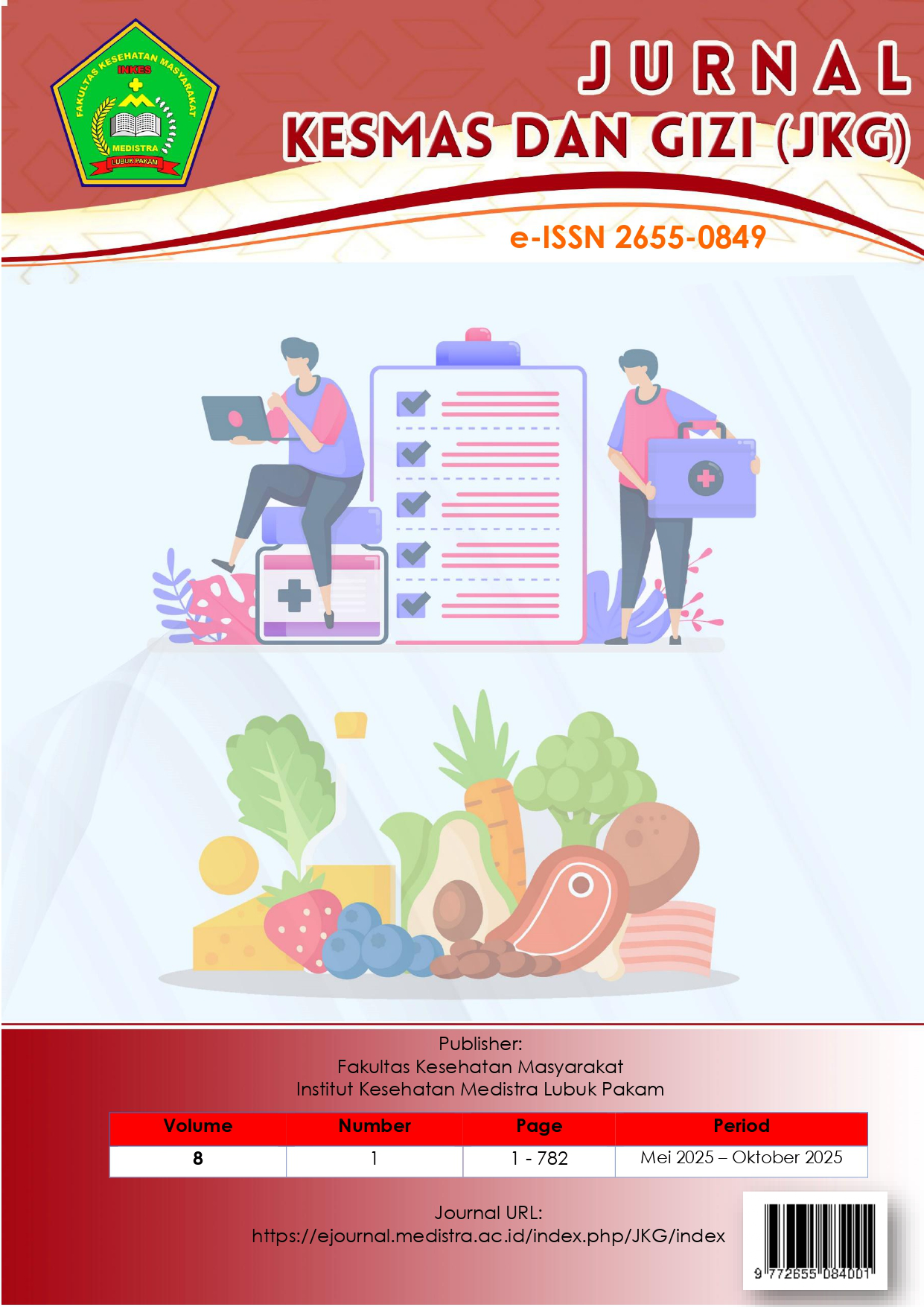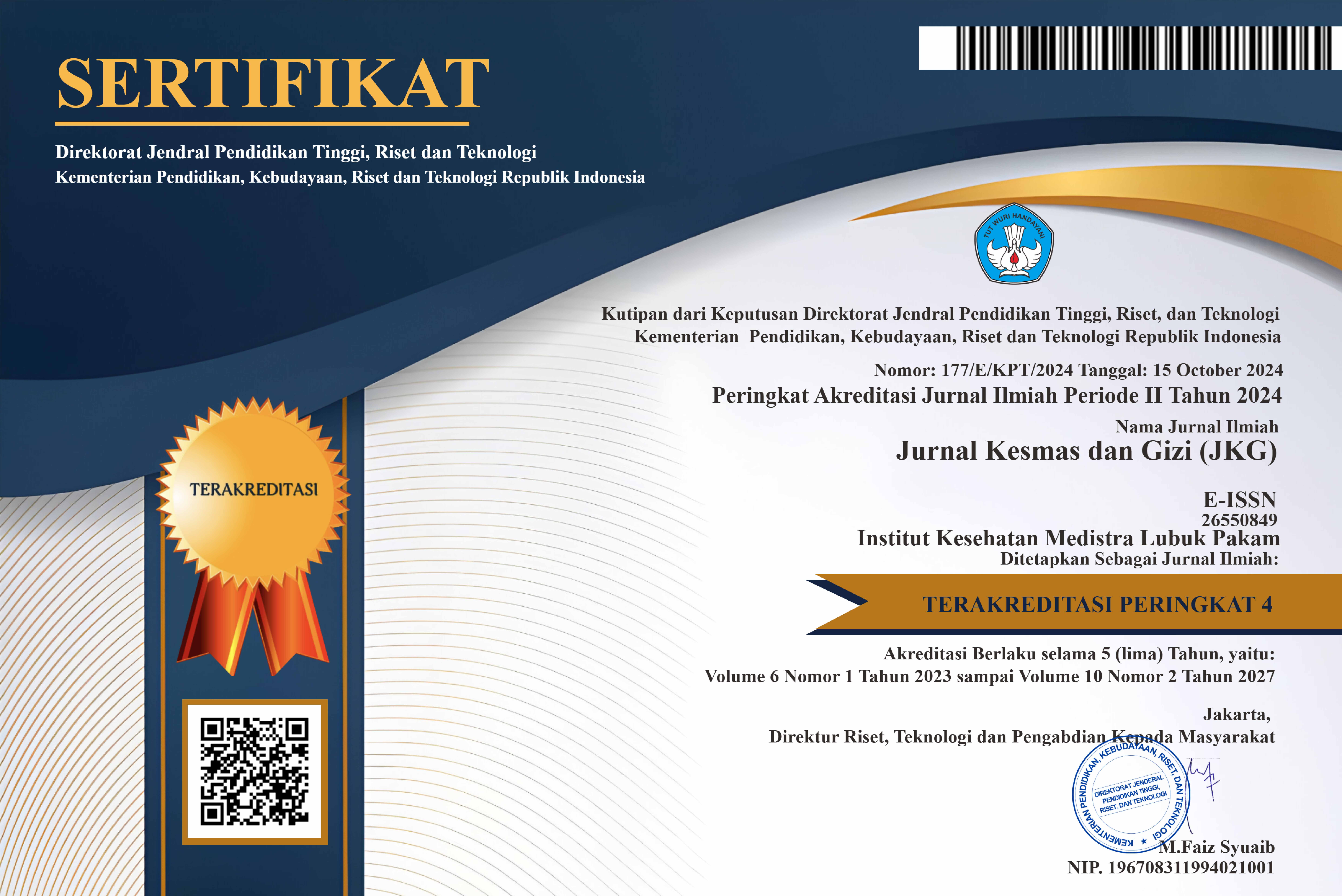Relationship Between Workload_and_Work Fatigue in Cleaning Service Officers at Grandmed Lubuk Pakam Hospital in 2025
DOI:
https://doi.org/10.35451/9nexbm51Keywords:
Beban Kerja, Kelelahan Kerja, Cleaning Service, rumah SakitAbstract
Cleaning service personnel play a vital role in maintaining hygiene and sanitation within hospitals as an integral component of healthcare services. Excessive and prolonged workloads can lead to work-related fatigue, which may decrease productivity and elevate the likelihood of occupational accidents. This study aims to examine the relationship between workload and work fatigue among cleaning service staff at Grandmed Lubuk Pakam Hospital in 2025. A quantitative research approach with a cross-sectional design was employed. The study involved all 65 cleaning service workers selected through a total sampling technique. Data were gathered using a structured questionnaire and analyzed using the Chi-square statistical test. The findings revealed that 29 respondents (44.6%) had low workloads, 20 respondents (30.8%) had moderate workloads, and 16 respondents (24.6%) experienced high workloads. Regarding fatigue levels, 23 respondents (35.4%) reported low fatigue, 24 respondents (36.9%) moderate fatigue, and 18 respondents (27.7%) high fatigue. The statistical analysis produced a p-value of 0.030, indicating a significant association between workload and work fatigue. It can be inferred that as workload intensity increases, the likelihood of experiencing fatigue also rises. Hence, effective and ergonomically oriented workload management strategies are essential to minimize fatigue and enhance the overall well-being and performance of cleaning service personnel within the hospital environment.
Downloads
References
[1] World Health Organization (WHO). (2020). Hospital Cleaning and Infection Prevention Guidelines. Geneva: WHO Press.
[2] Saut, H. (2011). Manajemen Kebersihan di Rumah Sakit: Panduan untuk Cleaning Service. Jakarta:Salemba Medika.
[3] Robinson, P. , & J. T. (2019). Human Resource Management: Managing Workload and Employee Performance. Pearson Education.
[4] Manuaba, A. (2013). Workload Analysis and Employee Performance: A Theoretical Perspective. Jurnal Ergonomi Indonesia, 9(2), 65–78.
[5] Hardi, B. , S. H. , & M. H. P. (2019). Pengaruh Konflik, Stres Kerja, Kepuasan Kerja, dan Beban Kerja terhadap Turnover Intention Karyawan pada CV Honda Karya Utama Kisaran. Jurnal Manajemen, Ekonomi Sains, 39–48.
[6] Wijaya, F. , et al. (2021). Beban Kerja dan Produktivitas Karyawan di Lingkungan Rumah Sakit. Jurnal Kesehatan Masyarakat, 16(4), 198–215.
[7] Suma’mur, P. K. (2013). Higiene Perusahaan dan Kesehatan Kerja (Hiperkes). Jakarta: Sagung Seto.
[8] International Labour Organization (ILO). (2012). Workplace Stress and Occupational Health: A Global Perspective. Geneva: ILO.
[9] Irwandy, R. (2015). Jakarta: Rineka Cipta. Kesehatan Dan Keselamatan Kerja (K3) Di Tempat Kerja.
[10] Manuaba, A. (2013). Workload Analysis and Employee Performance: A Theoretical Perspective. Jurnal Ergonomi Indonesia, 9(2), 65–78.
[11] Tarwaka, S. (2015). Analisis Beban Kerja dan Dampaknya terhadap Kesehatan Tenaga Kerja. Yogyakarta: Andi Publisher.
[12] Rahmawati, S. , & A. M. (2019). Gender Differences in Work Fatigue and Occupational Stress. . Jurnal Psikologi, 7(3), 212–230.
[13] Murleni. (2016). Hubungan Beban Kerja dengan Kelelahan Kerja pada Karyawan Laundry di Rumah Sakit Umum Daerah Dr. Achmad Mochtar Bukittinggi. . Fakultas Kesehatan Masyarakat, Universitas Andalas.
[14] Birthda Amini, & Suroto. (2018). Faktor Umur dalam Hubungan dengan Kelelahan Kerja. Jurnal Ergonomi, 15(2), 45–52.
[15] D.J. Priansa. (2018). Perencanaan dan Pengembangan Sumber Daya Manusia.
[16] Hardi, B. , S. H. , & M. H. P. (2019). Pengaruh Konflik, Stres Kerja, Kepuasan Kerja, dan Beban Kerja terhadap Turnover Intention Karyawan pada CV Honda Karya Utama Kisaran. Jurnal Manajemen, Ekonomi Sains, 39–48.
[17] Hasnidar, T. S. S. , H. W. , M. F. Y. M. , M. I. , Y. A. E. , S. A. , P. R. P. , S. E. , & Sulfianti. (2020). Ilmu Kesehatan Masyarakat. Yayasan Kita Menulis.
[18] Komalig, M. R. , & M. N. (2020). Hubungan Antara Umur dan Shift Kerja dengan Kelelahan Kerja pada Petugas Karcis Parkir Kawasan Megamas Kota Manado. . Media Publikasi Promosi Kesehatan Indonesia (MPPKI), 3(1), 26–30.
[19] Tillama, D. , & W. W. (2021). Workload and Occupational Health in the Modern Workplace. . Jurnal Manajemen SDM, 18(2), 77–89.
[20] Wiranti, N. , I. A. F. , & H. S. (2022). Hubungan Masa Kerja dengan Kelelahan Kerja pada Tenaga Medis. Jurnal Kesehatan Kerja, 9(3), 101–113.
Downloads
Published
Issue
Section
License
Copyright (c) 2025 Layari Tarigan, Keleng Ate Ginting, Teja Kusuma, Juwita Delima Bakkara

This work is licensed under a Creative Commons Attribution 4.0 International License.
Copyright in each article is the property of the Author.


























